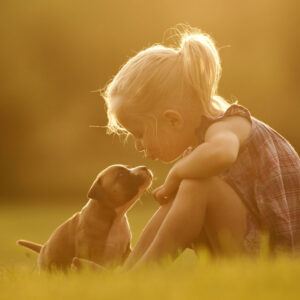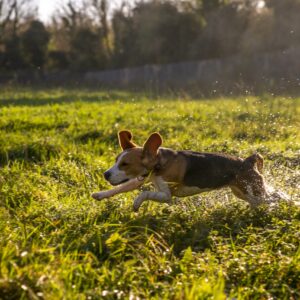Children and Dogs. It goes without saying that children and dogs can make some of the best friendships we’ve ever known. Children growing up with a dog, no matter what the age have a friend they will remember for life.
They learn kindness and compassion for others, have almost a live in play partner, a guardian and benefit from all sorts of things from stronger immune systems to being more confident and happy in life. Dogs, in turn, are usually completely devoted to their younger ‘pack’ members and throughout the history of man and dog, there has been thousands of cases of dogs doing anything to keep children safe. It is safe to say most people like the idea of their children growing up with pet dogs. However, while they can grow to be the best friendships in the world, it is the responsibility of the parent to always ensure the happiness, safety and comfort between the family dog and young children.
Dogs have lived alongside humans protecting them and showing them love and loyalty for thousands of years. Modern dogs have learned human’s habitual behaviours and you can be sure your dog will learn how to figure out your body language through your day to day behaviour and routines. They can learn the different personalities of the family, learn who the vulnerable family members are and how to be around them. However, it is important to know that dogs all have different personalities of their own and their communication and body language signals need to be understood too. Small children can naturally play rough with dogs but it is important that they are never allowed do what can come naturally to them, like grabbing ears, fur and tails, climbing or bouncing on them, sticking hands or fingers in food bowls, mouths or eyes, hitting etc. It is important to remember that dogs get hurt like people and even the most mild mannered can react to being uncomfortable or hurt. If you had a toddler jump up and down on your back when you were trying to eat your dinner, you would eventually let that be known too, perhaps by shouting or yelling, however, dogs do this with their teeth and the end result is devastating. Children should be shown how to interact with dogs, how to read the dog’s body language and how to approach dogs. It is important that children always understand that dogs get tired, need to be left alone when they are trying to eat, rest or play with their toys and should be treated gently, compassionately and with kindness. The most important thing for parents to know is that children and animals should never be left alone unsupervised as a variety of things can happen in the blink of an eye and it is just not worth putting the child or dog at risk. Calming Signals Dogs have a variety of ways of letting their humans know when they uncomfortable and anxious with their behaviours and body language and it is up to the parents of small children to understand these signals. Signals like these are called Calming Signals and can show in a variety of ways such as a dog’s body language going stiff or rigid, licking of the lips, ‘whale eye’ – when a dog shows the whites of his eyes, looking or glancing away not making eye contact, yawning, moving away, growling or rumbling, stripping his teeth, air snapping and pinning his ears back. When a dog does one or all of these signals, he is desperate to try to communicate that he is uncomfortable in a situation or is being hurt. A dog needs to be left alone when he is giving off any of these signals. When these signals are ignored or the dog feels like his attempts of letting his beloved humans know he is uncomfortable or hurt are being ignored, the dog can feel like he has no choice but to react more intensely like biting. If a dog bites a family member, it can turn the household upside down and, often, parents will say something like “it came out of the blue”, “they’ve always been the best of friends” “she’s always been really good with the kids” or “he even let’s the child sit on him”. It’s a very scary thing to happen but usually anyone that can read a dogs’ body language will say “I’m surprised it didn’t happen sooner.” Adults who let children climb or jump on dogs are irresponsible and it is not cute. It is unfair on the dog and it is unfair on the poor child who ends up bitten. This is how dogs end up getting put down or rehomed and children end up hurt. There is no dog breed more prone to biting than others, any dog can make a perfect family pet but compassion and understanding needs to be present at all times so no one ever has to ask why their once trusted family companion would bite an innocent child.





